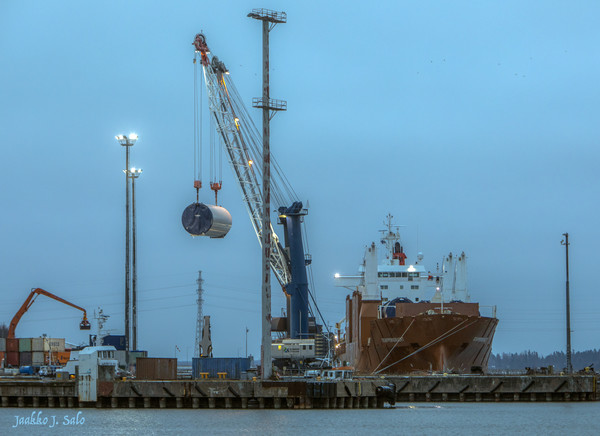Loading and Unloading in a Swirling Wind
The Port of Vaasa Provides Winter Know-how for the Wind Power Industry

Cargo ships glide to the port of Vaasa all year round to unload, parts of wind turbines, and other parts of large projects such as engines, process industry boilers or cranes onto the quay or directly onto the trailers. About twenty experienced professionals at port operator Blomberg Stevedoring ensure that these valuable parts and pieces are safely moved ashore, forwarded to the storage or straight to their destination also in a swirling wind.
– The processing of wind power station components, for both blades and the frame, is a precise job. They should not be damaged. In that case, they cannot be used without repair work approved by the manufacturer, which in turn means project delays and high costs. All of our experts have more than ten years of experience in loading and unloading freight under all circumstances, says Björn Knutar, Sales Director, praising his employees and continuing:
– Dealing with large parts requires both well-coordinated tandem lifts and team members’ quick reactions. For example, they have to climb, using the proper safety gear, of course, to attach crane hooks or to remove wind power station blades from their mounting frames.
– Parts are lifted onto the pier or transport trailer for wind turbine blades and will continue their journey directly to the wind farm site or remain in temporary storage. Approximately 90 wind turbines pass through the Port of Vaasa annually. For example, the currently arriving project comprises parts for about 40 wind power stations, and they are stored in a fenced and guarded area for the winter. Also, we clean the parts from the snow load during storage and prepare them ready in February — still in the middle of winter and often covered in ice — to be transported forward, Mathias Maris from Blomberg Stevedoring completes.
Building a More Flexible Supply Chain
Tommi Tuominen, development director at the Port of Vaasa, explains that the storage fields at the port are an important buffer offering flexibility in managing the supply chain of wind power stations:
– Flexibility is important for bigger projects and for operators to be able to adjust shipping according to, for example, component production or shipping costs. This kind of planning is possible when there is a temporary storage area from which the parts will be forwarded after being in storage for a short time or a bit longer. The port is constantly being developed according to the needs of wind power operators. Work is being done to enable a widening of the fairway from 100 meters to 140 meters This is to ensure that bigger vessels can reach the port, as the projects are constantly becoming larger and larger.
– Also, the quay capacity will be increased in three different phases. In the first phase this year, Lasse’s quay will be lengthened by 145 metres, and at the same time, the quay area will be expanded by 7000 square metres. In the long term, there will be 20 hectares of new port space while the quay is extended from the Coal quay to the breakwater, Tuominen continues.
The development of logistical conditions in the Vaasa region also includes ensuring the safe forwarding after unloading the cargo at the port of discharge, Anna Måtts-Fransén, VASEK’s expert in logistics, reminds:
– Not only fairways but also roads and other routes must be fit for use to enable bigger and more significant project transports to and from the port as well as to international transportation routes. Connections to the GigaVaasa area are also of great importance for the port.
 Suomi
Suomi

